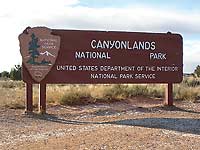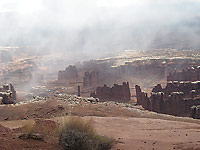 No photo can convey the depth and raw beauty of this dramatic, big sky country. To truly appreciate the staggering vastness of Canyonlands National Park you must see it through your own eyes - the stunning showcase of 300 million years of Earth’s geologic history - a fractured, layered landscape that has been eroded in to a tangled web of canyons, mesas, buttes, fins, and spires. No photo can convey the depth and raw beauty of this dramatic, big sky country. To truly appreciate the staggering vastness of Canyonlands National Park you must see it through your own eyes - the stunning showcase of 300 million years of Earth’s geologic history - a fractured, layered landscape that has been eroded in to a tangled web of canyons, mesas, buttes, fins, and spires.
This expansive territory encompasses 527 square miles, and before it achieved park status few besides Native Americans, cowboys, river explorers and uranium prospectors entered this rugged corner of southeast Utah. Even today most of it remains a wild, hard-to-reach land where bighorn sheep, coyote, deer and kit fox still freely roam - a protected habitat that is particularly important for the desert bighorn, whose population has plummeted dramatically since modern man arrived.
In the late 1950s and early 60s, Bates Wilson, then superintendent of Arches National Monument, led groups of scientists and government officials into “the canyonlands.” When they sat around the campfire in the evening, the talk inevitably turned to the possibility of designating this spectacular segment of land as a national park.
United States Senator Frank E. Moss, who represented Utah, introduced the legislation, saying “I will never lose sight of the fact that the most important thing for Utah and the United States is to set aside (and) preserve this beautiful area as a great national park in the tradition of Yellowstone, Grand Canyon and Yosemite.” And so the spark of an idea became a reality in 1964.
The gaping depth of two large canyons has been carved out by the surging waters of the Colorado and Green Rivers - major barriers within the park that segment it into three distinct areas: The Needles (south), The Maze (west) and Island In The Sky (north). Surrounded by a sweeping, isolated background, the sheer-walled plateau of Island In The Sky juts up like a desert island. At an average elevation of 6100 feet, it’s the highest district in the park, and the drop off to the banks of the Colorado and Green is a dizzying 2,000 feet. 
On a clear day at Grand View Point this is what you will see: Monument Basin, the White Rim Road and The Totem. Beneath them is the Colorado River Canyon. In the far distance visitors can also pick out the Needles with its needle-like spires and Cleopatra’s Chair sitting above the Maze. But wait there’s more - a wondrous horizon-to-horizon view of three distinctive mountain ranges – the La Sals, the Abajos and the Henry Mountains. At this viewpoint, a big sign points out all these landmarks.
To get there, drive ten miles north of Moab on Highway 191. At Highway 313, turn left and drive another 25 miles to the park’s entrance station. Then continue 19 additional miles to the viewpoint and trailhead.
A one-mile, easy-going hike along the rim enriches this experience immensely. Bundled up for a nippy, wintry walk, I am happy to find no snow lingers on the trail. Six years ago three feet covered the ground, a condition that lasted for weeks, and I was aghast when a ranger told me he’d been using snowshoes to get around! Fortunately this is a seldom-seen event – a freakish whim of the weather gods. 
Right now I am contemplating how the current weather is going to pan out. Yesterday it snowed and rained. Today low hanging clouds remain, and sometimes the mist hangs low as dozens of fluffy white puffballs drift up and down the canyon walls – a surprising sensation for southeast Utah.
At the moment, conditions are perfect for a brisk, invigorating hike as I traipse through the trademark vegetation of snakeweed, Indian rice grass, Mormon tea, yucca, blackbrush, pinyon pines, and junipers. They have adapted well to their high desert environment by hunkering down to wait until the life-giving rains return.
The minimal change in elevation allows for a leisurely stroll, as several raucous ravens fly above on this clearly marked, well-maintained trail. With piles of rocks called cairns and a series of hand-made steps chiseled out of rock, it would be difficult to lose track of where I’m going! Then - whoa - suddenly I’ve run out of real estate. Abruptly this trail stops at the edge of the precipice just when a measly sun finally peeks through the clouds as they cast their restless shadows on the dramatic landscape below.
So maybe, just maybe I’ll get a good performance after all, and carefully choosing an on-the-edge front row seat I am ready for an engaging show. Across an azure turf wayward clouds whirl and twirl - expand and contract – separate and reunite – morphing and twisting from fleecy white dragons to delicate lacy fingers. This magical, constantly changing picture takes the rough edges off the canyonlands vista as it portrays a whimsical hide-and-seek scene.
Beneath the clouds I look around at an impressive exhibition of seemingly endless terrain as I gaze down 1200 feet to Monument Basin. Vertical fractures in the sandstone have caused the rocks to erode into steep-sided walls, columns and pinnacles – an area formerly called “Standing Rock Basin” for obvious reasons. The Totem, a sandstone spire with a height of 305 feet, is the tallest formation on this plateau. Then looking south Junction Butte strikes an equally impressive pose.
The White Rim Trail snakes its route through Monument Basin seeking the best path through an obstacle-laden land. Named for its white appearance, it is at the top of the Cutler Formation, a wide bench of sandstone that was deposited 225 million years ago. In the 1950s uranium prospectors constructed a road on this rim to access the uranium deposits in the area - a short-lived mining boom that came to a halt by the end of the decade. Since that era, the White Rim Trail, which is almost 100 miles long, has grown in popularity with mountain bikers and jeepers.
Stretching my vision down to the lowest depths, I can make out a sliver of the Green River. Farther up and beyond I feast my eyes on the Maze and the Needles that hazily slip in and out of the clouds. And out there on the horizon, the La Sals, Abajos, and Henry Mountains are obscured in a veil of clouds as now and then their majestic, snow-laden profiles manage to break through their cottony fluff.
Enchanting as this wizardry production is, after a while the chill finally forces me to leave. But I’ve had ample uninterrupted time to savor an extraordinary event during this brief window of off-season solitude – a blissfully quiet viewpoint shared with a mere handful of people.
|